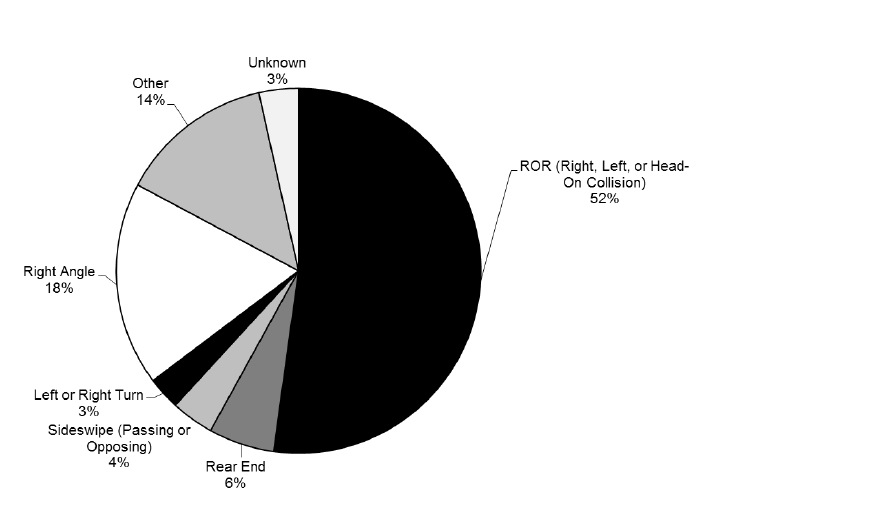INTELLIGENT TRANSPORTATION SYSTEMS INSTITUTE
UNIVERSITY OF MINNESOTA
Executive Summary
In Minnesota, 395 individuals were killed in traffic crashes in 2012 and of those crashes 52% were the result of a run-off-road (ROR) crash (Minnesota Crash Facts, 2012). Similarly, single-vehicle ROR crashes in 2009 accounted for approximately 53% of all fatal crashes in the United States (Fatality Analysis Reporting, 2009). The cause of these types of crashes can be attributed partially to environmental factors (e.g. curves, lane/shoulder width, surface conditions, and speed limits), but are more often attributed to driver-related factors (e.g. error, distraction/inattention, fatigue, drug/alcohol consumption, and aggressive driving).
While substantial steps have been taken to flatten curves, widen roads/shoulders, impose barriers, and remove collision-prone objects, ROR crashes consistently account for nearly half of all fatal crashes. The introduction of rumble strips to notify drivers of an impending lane departure has spurred other methods of notifying and preventing lane departures via in-vehicle systems (e.g. auditory/visual warnings and haptic/tactile alerts). While these Lane Departure Warning Systems (LDWS) show some promise in successfully warning drivers of impending lane departures, their ability to appropriately capture attention, convey information, and guide an appropriate response must still be refined to consistently prevent ROR crashes. Haptic warnings presented through the seat or steering wheel have an advantage of swift comprehension by drivers and steering wheel torque can simultaneously indicate the direction in which the driver should steer to return to one’s lane; however, research has indicated that drivers perceive torque as too intrusive.
The purpose of this pilot study was to review the literature to examine the factors that contribute to ROR crashes and identify gaps in the literature, identify current and promising future countermeasures to reduce the occurrence of ROR crashes, and to conduct a pilot study examining the utility of a promising countermeasure. This pilot study hypothesized that torque would be a superior LDWS compared to other methods, but drivers would rate it poor with respect to usability because of its abrupt onset and strong intensity. Additionally, this pilot study proposed that perceptions of poor torque usability could be ameliorated by presenting additional haptic warnings prior to torque onset and decreasing the intensity of the signal while maintaining its effectiveness. Participants were tested in 3 separate experimental groups to determine the effectiveness of the various LDWS in avoiding ROR crashes and system user satisfaction compared to no warning. Group 1 tested haptic warning systems (torque, seat pan, and seat back) presented individually, at full intensity. Group 2 tested dual LDWS (seat pan+torque and seat back+torque) presented sequentially, at medium intensity compared to medium intensity torque and control conditions. Group 3 tested triple LDWS (seat pan+seat back+torque and seat back+seat pan+torque) presented sequentially, at lower intensities compared to low intensity torque conditions.
Contrary to the research identified in the review of literature, results of the pilot study revealed that the individual LDWS did not differ in response times, but did reveal faster response and re-entry times for younger drivers compared to older drivers. The sequential countermeasure presentations (dual LDWS, and/or triple LDWS) did not reveal additional differences between individual and dual LDWS, however the single torque countermeasure resulted in quicker responses than the triple LDWS method. The results suggest that multiple countermeasures, despite being presented sooner in the countermeasure cycle, did not decrease driver response time or the amount of time out of lane. These findings suggest that multiple presentations of information did not reduce or impede driver response compared to singular countermeasure presentations; however, subjective ratings of the torque only condition compared to two or three countermeasure presentations was less preferred by participants although not all significant. Moreover, the intensity of the torque was decreased in sequential countermeasure presentations and achieved similar reaction and recovery times suggesting a less intrusive, but equally effective torque is possible when primed with other haptic countermeasures prior to its activation.
The results suggest additional research that can integrate haptic feedback from in-vehicle countermeasure systems with infrastructure related technologies (e.g., rumble strips) in an effort to create a combined infrastructure/driver performance mitigation technique would be beneficial and have potentially better user acceptance of such systems. Furthermore, the addition of information to the review of literature and review of infrastructure specific techniques can be valuable next steps in investigating ROR mitigation techniques.
Figure 1: Amount of run-off-road crashes compared to other crash types in Minnesota for 2012.
Download full report (PDF): Mitigating Run-Off-Road Crashes
About the Intelligent Transportation Systems Institute
www.its.umn.edu
The Intelligent Transportation Systems (ITS) Institute is a national University Transportation Center (UTC) funded through the Safe, Accountable, Flexible, Efficient Transportation Equity Act: A Legacy for Users (SAFETEA-LU) federal transportation bill, passed in 2005. This funding continues the Institute’s efforts initiated under the Intermodal Surface Transportation Efficiency Act of 1991 (ISTEA) and the Transportation Equity Act for the 21st Century (TEA-21) in 1998.
The Institute plans and conducts activities that further the mission of the UTC program of the United States Department of Transportation (USDOT). That mission is to advance U.S. technology and expertise in the many disciplines that make up transportation through education, research, and technology transfer activities at university-based centers of excellence.
Tags: Accidents, Crashes, Intelligent Transportation Systems Institute, ITS, Minnesota, MN, University of Minnesota






 RSS Feed
RSS Feed